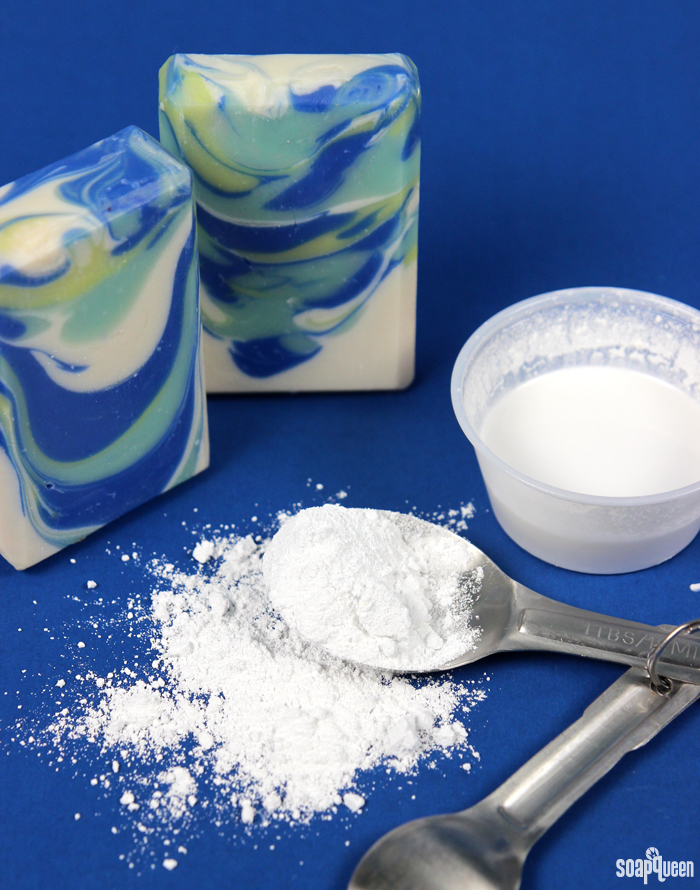
Pigments and oxides are one of the most popular colorant options for cold process soap. They are non-bleeding and don’t morph in the high pH environment of freshly poured soap. Oxides come in a wide variety of hues, and are easy to mix to create unique colors. One of the most popular colorants is titanium dioxide, which gives soap a white color. It’s commonly used to transform soap from cream to white, or to lighten other colors.
A natural white opaque pigment, titanium dioxide is used in a wide variety of applications including paints, cosmetic products and food. The mineral is processed to remove impurities, resulting in a pure white color. The titanium dioxide found at Bramble Berry is both oil and water soluble, making it a great option for cold process soap. Titanium dioxide is commonly used in commercial sunscreen products because of its ability to absorb UV light.
Titanium dioxide is considered a safe pigment with no adverse effects in cosmetic applications and is approved by the FDA. Despite this, titanium dioxide is a source of some controversy. The main source of its controversy comes from a study by Lee, Trochimowicz & Reinheardt (1985). In this study, rats were exposed to large amounts of titanium dioxide dust for six hours a day, five days a week for two years. These rats showed slight increases in lung tumors and other respiratory problems including pneumonia and tracheitis. The results of this study have lead some to assess titanium dioxide as a possible carcinogen. The abstract of the study does conclude that the results of this study may not be relevant for humans:
“The lung tumors were different from common human lung cancers in terms of tumor type, anatomic location, tumorigenesis, and were devoid of tumor metastasis. Therefore, the biological relevance of these lung tumors and other pulmonary lesions for man is negligible.”
The potential adverse effects of titanium dioxide are available on the MSDS sheet, and states that skin exposure to titanium dioxide is virtually harmless. It also states that is it not believed to be absorbed through intact skin. The MSDS does note that it may be harmful if inhaled and could cause respiratory tract irritation.
There is one type of titanium dioxide that should be avoided in small-batch cosmetics. Like many other mineral pigments, titanium dioxide is available in varying sizes and grades. Measurements of mineral pigment particles include coarse, fine and ultrafine. Ultrafine pigment particles are also referred to as nano particles. Nano particles are measured as less than .01 microns, or 100 nanometres. In a study by Kumazawa et. al (2002), evidence supports that danger to skin cells is dependent on the size of the particle of titanium dioxide. Nano particle titanium dioxide may be able to penetrate the cell through skin contact (though even that is up for some discussion). The health risks of nano particles remain mostly unknown, and are contingent on completion of studies by the FDA and other agencies. Titanium dioxide sold at Bramble Berry is not nano particle. The safety of our products, and our customers, is top priority.
To use titanium dioxide in cold process soap, we recommend dispersing it in a lightweight liquid oil at a rate of 1 tsp. colorant to 1 Tbsp. oil. Because titanium dioxide is a fairly large pigment, use a mini mixer to help work out any clumps. Some soapers choose to micronize their titanium dioxide by using a coffee grinder to break up any large clumps of color. This is an optional step, but it does help prevent streaks of white showing in the final soap. Because Bramble Berry titanium dioxide is both water and oil soluble, you can also disperse it in distilled water. Just keep in mind that titanium dioxide is prone to glycerin rivers, and dispersing it in water can increase the likelihood of them.
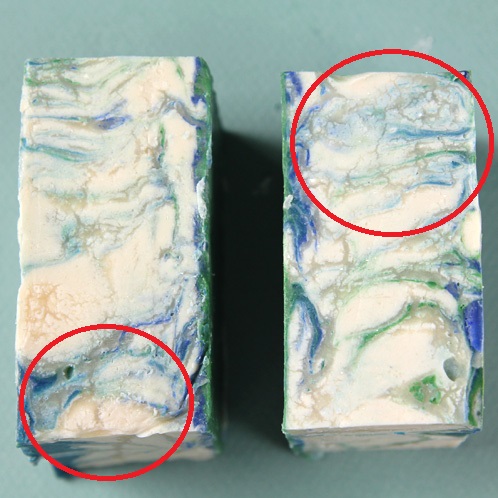
Glycerin rivers are caused by glycerin within the soap congealing, which results in clusters or “rivers” of glycerin. Above, you can see an example of glycerin rivers in soap colored with titanium dioxide. Glycerin begins to congeal when the soap overheats. To prevent glycerin rivers, consider lowering your soaping temperatures by 10 degrees. Reducing the amount of water in your recipe can also prevent glycerin rivers, which is why dispersing titanium dioxide in water can promote the glycerin to congeal. Click here to read more about glycerin rivers and how to prevent them.
Titanium dioxide is used in a wide variety of cold process projects. In the Black, White and Gold All Over Cold Process Soap, titanium dioxide gives the bottom layer a bright white color which really pops against the black. A similar design is found in the Lemon and Poppy Seed Cold Process, which features cheerful layers of yellow and white soap. Titanium dioxide is also useful for lightening various colors to create tints. A great example of this is in the Smoky Bay Cold Process Soap, which uses titanium dioxide to create various hues of gray.
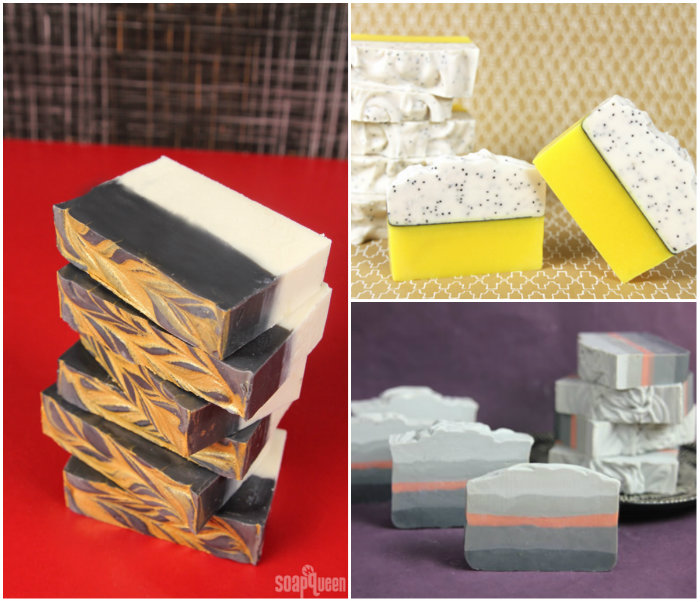 Left to right, clockwise: Black, White and Gold All Over Cold Process Soap, Lemon and Poppy Seed Cold Process, Smoky Bay Cold Process Soap
Left to right, clockwise: Black, White and Gold All Over Cold Process Soap, Lemon and Poppy Seed Cold Process, Smoky Bay Cold Process Soap
For melt and pour soap, the Titanium Dioxide Color Block mixes into soap easily and smoothly. You can also use the White Liquid Color, which is titanium dioxide evenly dispersed in glycerin. Titanium dioxide is both lip and eye safe, which means you can use it in your lip balm and eye shadow recipes. In the Honey Kisses Lipstick and Soft and Creamy Blush Stick tutorials, a small amount of titanium dioxide gives the products a more opaque quality.
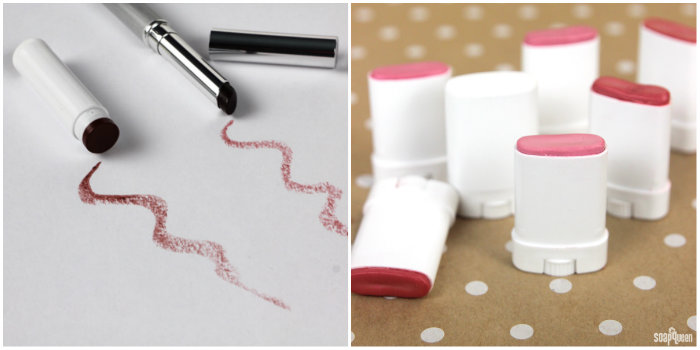 Left to right: Honey Kisses Lipstick, Soft and Creamy Blush Stick
Left to right: Honey Kisses Lipstick, Soft and Creamy Blush Stick
What is your favorite way to use titanium dioxide? I always have it on hand for my cold process recipes!
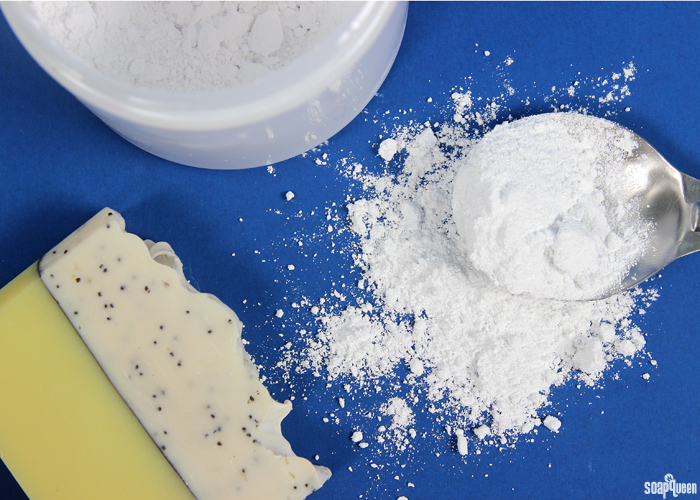




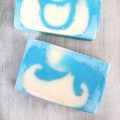
i have lotion base and i want to make whitening lotion. how much should i add titanium dioxide? thank you
I would recommend starting with about 1/4-1/2 a teaspoon per pound. You can add more from there if you like. You can mix the titanium dioxide with your fragrance and add it after the lotion is emulsified, or mix it right into the water before adding to the oils.
-Kelsey with Bramble Berry
Hi there!
Is it possible to add the TD to the lye water? I understand that adding it in very hot water creates glycerin rivers. If that’s the case, is it possible to add TD into the lye water just before mixing the lye water and oils (when the lye water temperature is around 100-110 degrees)?
Yes, that will work just fine. You can add that to the cooled lye water and stir well. It is a bit tricky adding titanium dioxide before making soap, as you don’t know how much you need. You may start with about 1-2 teaspoons and see what color that gets you. If it’s not bright enough, you can prepare some extra mixed with oil or water to add at trace.
-Kelsey with Bramble Berry
Hi, thanks so much for always providing amazing resources for soapers. I just made a batch of soap that had 4 lbs of oil and accidentally used titanium dioxide at 1 tbs/oil instead of tsp :(.
What happens when it is overused? Is my batch useless now?
The batch will be totally fine to use! With more color, it may lather white. If that’s the case, just make sure to rinse well and keep a towel nearby for any transfer. It should wipe off easily. 🙂
-Kelsey with Bramble Berry
Hi!
Great article and advice!! Perhaps I have missed this being answered….Does it matter if mixing in oil rather than water with CP? Or is it more of a preference?
Thanks!
Sarah
The titanum dioxide can be mixed in both water and oil! We tend to use oil more than water. If the titanium dioxide is mixed in water and it gets pretty hot, it is more likely to get glycerin rivers: https://www.soapqueen.com/bath-and-body-tutorials/tips-and-tricks/river-runs-deep-explanation-glycerin-rivers/
It is definitely personal preference though. I would recommend trying both methods to see which one you like best. 🙂
-Kelsey with Bramble Berry
Hi, I’m from North east of Indian. I am very interested in homemade soap. I have been learning from you guys so much. I have tried natural colour like using wheatgrass , tomato powder in my cp soap. I want to try titanium dioxide this time. Can anyone tell me what type i shoud buy.
As long as the ingredients are just titanium dioxide, that should be fine! You’ll want to avoid any titanium dioxide options that have additives. Pure titanium dioxide works best. 🙂
-Kelsey with Bramble Berry
Can I use Titanium Dioxide white melt and pour soap bar, instead of the Titanium Dioxide power and water product you mix, in my hot or cold goat milk recipe?
And if I can use the soap and melt bar…do I just melt it in the microwave and pour into oils or just shave it into the oils…at a light trace?
You can add melt and pour to cold process soap, but it doesn’t color it very effectively. Instead, the melt and pour dries at a different rate and gives the soap a unique sort of magma look. You can see that in this tutorial: https://www.soapqueen.com/bath-and-body-tutorials/cold-process-soap/cp-mp-magma-soap/
If you want to color your soap, I would recommend mixing the titanium dioxide with a lightweight oil and adding 1 dispersed teaspoon at a time. That will color it nicely. 🙂
-Kelsey with Bramble Berry
Hi! I appreciate all of your informative responses! I’ve been making soap for quite a few years, but have not used Titanium Dioxide very often. I recently made a batch of hot process, in the summer, and it because of the humidity, it dried very slowly with a “glycerine like” crust on the outside. I usually superfat at 6 or 7 %, which was obviously too much for the hot, humid summer. So I am rebatching it, and want to add T.D to give it a lighter, more uniform colour. I didn’t see any other questions regarding this, so I’m wondering which re-batching method works the best when using T.D? Also, how much per pound of soap should be used, what should I mix it with, and can it be added at any time during re-batching? Thank you so much, in advance, for any help you can offer me. 🙂
Gratefully,
Lisa
Hi Lisa!
I would recommend the normal method for rebatching with titanium dioxide. That includes grating the soap and heating it on the stove or in a Crock-Pot. Learn how to do that here: http://www.soapqueen.com/bath-and-body-tutorials/cold-process-soap/soap-queen-tv-presents-how-to-make-rebatch-soap-2/
Normally, we recommend mixing titanium dioxide in oil. In this case, I think distilled water will work best! That way your soap won’t feel too oily. I would recommend mixing at a rate of 1 teaspoon titanium dioxide to 1 tablespoon distilled water (you can increase that to 2 teaspoon into 2 tablespoons, or 3 and 3 depending on your batch size). Then, add one dispersed teaspoon at a time until you get a color you like. I would recommend adding that near the end of the cooking process. The soap is softer then, so the colors will mix in more easily. 🙂
-Kelsey with Bramble Berry
Hi
I’ve seen on videos that some soapmakers seem to have a bottle of mixed titanium dioxide ready to use. I don’t make lots of soap but can see it would be handy to have a supply of the premixed solution. If I mix it with the light oil, how long would it last?
Carla in Brambleberry.com told me how I can buy your products in Europe (from YouWish in the Netherlands). I now have a 9-bar birch mold plus lots of your colors and fragrances. Now I hope to start being able to make some of the soaps you make in the videos!
Hi Hazel!
That’s awesome, the 9 Bar Birchwood Mold is so nice for soapmaking! You can definitely premix your colors before use. The best thing to mix it with is a lightweight oil like sweet almond or canola. You’ll want to store it in an airtight container in a cool, dry place. You can pop it in the fridge if you like. The color will last as long as the oil lasts. Then, make sure to mix it well before use as the color can settle. 🙂
Read more about oil shelf lives here: http://www.soapqueen.com/bath-and-body-tutorials/tips-and-tricks/free-beginners-guide-to-soapmaking-common-soapmaking-oils/
Sweet almond oil: https://www.brambleberry.com/Sweet-Almond-Oil-P3205.aspx
Canola oil: https://www.brambleberry.com/Canola-Oil-High-Oleic-P5548.aspx
-Kelsey with Bramble Berry
9 Bar Unfinished Birchwood Mold: https://www.brambleberry.com/9-Bar-Unfinished-Birchwood-Mold-P5169.aspx
How much liquid white titanium or titanium powder would I need for 1lb of a clear melt and pour base?
Hi Shannon!
It will all depend on just how white you’d like the base to be :). If using titanium dioxide in melt and pour soap, I would recommend the White Liquid Titanium. It is titanium dioxide dispersed in glycerin, which makes it really easy to add to melt and pour with no clumps. I would recommend starting with about 1/2 tsp. of the liquid titanium. Melt and pour soap is “what you see is what you get” so if it’s not quite white enough I would add more until you get the perfect shade. I hope this helps!
White, Liquid Titanium: https://www.brambleberry.com/White-Liquid-Titanium-P4053.aspx
-Amanda with Bramble Berry
Does mixing titanium dioxide with water or indeed with oil increase the amount of either in your recipe? If so should the amount used be factored in to the overall amounts required for saponification? I don’t want to add too much of either in case it makes the soap soft – or am I worrying needlessly?I want to use TD in some kind of liquid form as I have been just mixing the powder straight into the batter and sometime get some “talcy” like bits of white powder that drag across the finished cut bars. Will adding it in liquid form prevent this and are the powdery bits I have safe for the skin? I am sure it is not lye! Hope you can help. Thanks, Lizzie
Hi Lizzie!
When we mix titanium dioxide with oil, we consider it an additive and don’t subtract it from the oil amount. It helps that color disperse nicely and adds more luxurious oil to your soap. 🙂
If you’re worried about too much extra oil in your soap, you can decrease your superfat slightly. You can also mix the colors in your premade oils. To do that, use a spoon or a dropper to transfer some of your soaping oils into a separate container. Then, mix your colors in and add them at trace. You can see that in action in the Making Sunshine Soap video on Soap Queen TV: http://www.soapqueen.com/bath-and-body-tutorials/cold-process-soap/making-sunshine-cold-process-soap/
If mixing the titanium dioxide with water, we typically don’t subtract the water amount unless it’s larger. For instance, if you’re just adding a tablespoon, you can leave the amount the same. If you’re adding a couple extra ounces, you may want to discount that from the main batch to prevent the soap from getting too wet.
Also, a bit too much water and titanium dioxide can cause glycerin rivers. To prevent those, you can pop your soap in the fridge for 5-24 hours. 🙂
Read more about glycerin rivers and how to prevent them here: http://www.soapqueen.com/bath-and-body-tutorials/tips-and-tricks/river-runs-deep-explanation-glycerin-rivers/
Because titanium dioxide is a larger particle, it can cause streaks of color in the soap. To prevent that, we recommend micronizing the colorant. To micronize colorant, simply use a coffee grinder to blend the colorant to break up any clumps of color and prevent streaks of white from showing in the final soap. We like to use a coffee grinder that has a removable, stainless steel mixing area for easy cleaning. Then, you can disperse the colorant in water or oil. 🙂
-Kelsey with Bramble Berry
Droppers: https://www.brambleberry.com/Droppers-With-Suction-Bulb-P3802.aspx
Thank you so much for such a comprehensive reply!
You’re welcome, happy to help! 🙂
-Kelsey with Bramble Berry
what is the right amount of titanium dioxide for cold process thank you
Hi Elizabeth!
How much titanium dioxide you use will depend on the oils you use, the size of your recipe, etc. We recommend mixing at a rate of 1 teaspoon of color to 1 tablespoon of a lightweight oil, like sweet almond oil. If you’re making a larger batch, you may need to mix 2 teaspoons of the colorant into 2 tablespoons of oil, or 3 teaspoons into 3 tablespoons. Then, add the color 1 dispersed teaspoon at a time until you get a color you like! We like to prepare a little bit of extra color, just in case. Leftover dispersed oil can be stored in an airtight container for several weeks. 🙂
Learn more about preparing colors in this video: http://www.soapqueen.com/bath-and-body-tutorials/tips-and-tricks/learn-prepare-colorants-cold-process-soap-making/
-Kelsey with Bramble Berry
Will titanium dioxide keep fragrances from discoloring my soap? Would I use it at the same rate as above?
Hi Pam!
That’s a great question! The titanium dioxide can help lighten darker batter. For instance, we used it in our Exfoliating Green Tea Bars to lighten the discoloration from tea: http://www.soapqueen.com/bath-and-body-tutorials/cold-process-soap/exfoliating-green-tea-cold-process-bars/
While titanium dioxide may lighten fragrance discoloration, it will still turn brown. So you can definitely use it with a discoloring fragrance, just keep in mind it won’t keep the batter white.
However, you can still work with a discoloring fragrance! If you like, you can put all the fragrance into one layer. That way just one layer will discolor. We did that in the Goat Milk and Oatmeal Cold Process Soap: http://www.soapqueen.com/bath-and-body-tutorials/cold-process-soap/goat-milk-oatmeal-cold-process-soap-tutorial/
You can also pour the fragrance into one color, and keep it on the lower side. You can keep that soap lightly scented. We did that with the Pumpkin Spice Swirl Cold Process Soap: http://www.soapqueen.com/bath-and-body-tutorials/pumpkin-spice-swirl-cold-process-tutorial/
If you like, you can also blend the discoloring fragrance with a non-discoloring scent. The discoloring fragrance can go into the darker areas, and the non-discoloring can go in the lighter areas. 🙂
Learn more about fragrance discoloration and get some ideas here: http://www.soapqueen.com/bath-and-body-tutorials/tips-and-tricks/why-did-my-soap-turn-brown/
Hope that helps! If you have any other questions let me know. 🙂
-Kelsey with Bramble Berry
Clear and vanilla free fragrances: https://www.brambleberry.com/Clear-Vanilla-Free-C491.aspx
Thanks for the info give.at what point do i add TD during the production process?
You’re welcome, glad you like the post! We recommend adding the titanium dioxide at thin trace. That is when your soap is emulsified, but not too thick. The color mixes in really nicely then. 🙂
You can see when to add titanium dioxide in the Silky Berry Cold Process Soap video: http://www.soapqueen.com/bath-and-body-tutorials/cold-process-soap/silky-berry-cold-process-soap-on-soap-queen-tv/
And learn how to prepare your colorants for soaping here: http://www.soapqueen.com/bath-and-body-tutorials/tips-and-tricks/learn-prepare-colorants-cold-process-soap-making/
-Kelsey with Bramble Berry
Thank you. Most informative article as always, much appreciated.
Can a quantity of TD be premixed & kept for a period of time for convenience?
For example in a squirt bottle.
To the person who asked about making up a TD solution ahead of time in a “squeeze bottle” to use as needed. Absolutely, I do this all the time. I put a small rock (or a small ball bearing if you have one) in the squeeze bottle of TD & water. ( I mix my TD in water.) When I go to use the squeeze bottle of TD/Water, I just shake it up real well, this is where the rock helps with agitation. Just make sure you have a cap on the top of the squeeze bottle when you shake, or at least put your finger over the tip of the cap.
Hi Julie!
You can definitely mix it up ahead of time! You can store your Titanium Dioxide in a lightweight oil, or distilled water. If you’re storing that Titanium Dioxide in water, I would recommend keeping it in an airtight container and in the fridge. There is a chance Titanium Dioxide stored in water can grow mold, so keeping it in the fridge helps prolong the shelf life of the color. 🙂
Also, thanks so much for your tips Marleny! The rock is a great idea to get that all mixed up nicely, as the colorant will settle as it sits.
-Kelsey with Bramble Berry
I believe I already stated this, the best white I have had from titanium dioxide is when I heat up shea butter and disperse my titanium dioxide into melted shea butter. When I am ready to mix it in my batch of soap I just heat it up again and stir it in my already scented batch of soap. I have found this to work really well for me. I have only done it three times but my other attempts to use titanium dioxide have had glycerin rivers. The light oil doesn’t bind it well enough for me. Thanks for the article, Sincerely, Kristie
Hi Kristie!
That is an awesome tip, I have never thought to do that! I’ll have to give it a try. Thanks for sharing. 🙂
-Kelsey with Bramble Berry
To get a really white in goat milk soap – what is the typical amount that should be used per pound of oils?
Hi Lani!
It’s tricky to give you an exact measurement! How much titanium dioxide you use will depend on how yellow your soap is. This is especially the case with goat milk soap, as milk that gets too hot can discolor.
To start out with a neutral base, we recommend freezing the milk before adding the lye. That prevents it from scorching. Read more in the How to Add Lye to Milk for Cold Process Soap: http://www.soapqueen.com/bath-and-body-tutorials/tips-and-tricks/how-to-add-lye-to-milk-for-cold-process-soap/
Then, I would recommend mixing the titanium dioxide at a rate of 1 tsp. of powder to 1 Tbsp. of light carrier oil (if you have a larger batch, you may need more). Then, add that dispersed titanium dioxide in 1 tsp. increments until you get the color you like. That may mean just 1 teaspoon, or a couple tablespoons. 🙂
-Kelsey with Bramble Berry
Great information…especially about the “rat study” done. I have a feeling we would all have lung problems/tumors if we were exposed to any kind of dust after 6 hours a day, 5 days a week for 2 years.
Thanks….
Hi Joan!
So glad you found the post helpful! We thought it was important to include the results of that study so people are informed. 🙂
-Kelsey with Bramble Berry
Thanks for this
Very interesting
You’re welcome Odette! Thanks for reading. 🙂
-Kelsey with Bramble Berry